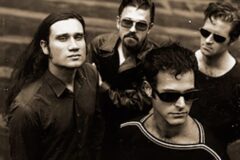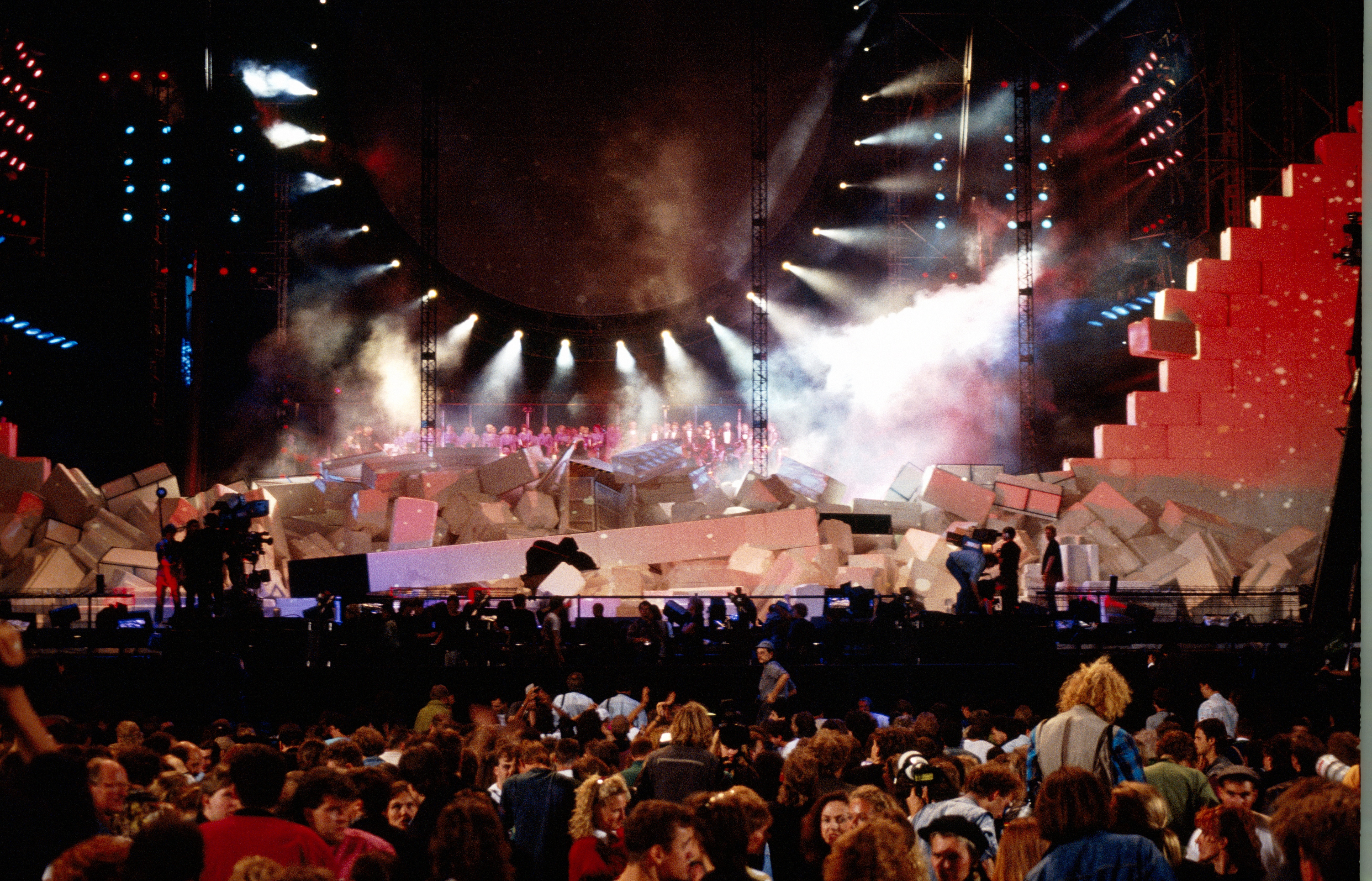The day after The Wall concert in Berlin’s infamous Potzdamer Platz, David Bates, Dawn Bridges, and Chris Roberts from PolyGram Records, and I drove to East Berlin. Checkpoint Charlie was gone and you no longer needed visas to cross from one Berlin to the other, but traffic at the main crossings was congested. So we looked for an alternative route and found, literally, a hole in the wall, and, like Alice stepping through the looking-glass, drove through it into an East German building complex.
It was completely quiet, a perfectly ordinary Sunday afternoon. We parked on the empty street. The building project was drab, of course, but sunlit, and its grassy backlot was lifeless, broken ground that separated the apartments from the road, which ran along the internal edge of the awful, death-chilled wall. We got out of the car and went up to the wall to pick up souvenirs, fragments of granite tyranny lying at the base of this now defeated monster. For 28 years this barrier forbid an entire people to touch it and now four American vacationers rummaged among its remains for choice paperweights, picking up and tossing aside imperfectly shaped stones and stacking up appealing ones. There were human-sized holes in the wall, like crude doors, and we stepped in and out of them, to find better chunks, crossing back and forth from East to West, half a dozen times in five minutes. The largest chunks were on the west side, but the colorful ones were on the east, where liberated East Germans had gleefully graffitied the canvas that jailed them.
A couple of East German teenagers were enterprisingly bashing colored chunks out of the wall to sell to people like us. We could have picked all we wanted off the ground, five feet from where the kids operated, but my friends each bought pieces from them and, satisfied with their overall haul, returned to the car. I relented and went back to one kid and bought two pieces from him, too. Just then an East Berlin police car rolled slowly past. I smiled at the impassive-looking cops in the car, cradling rocks in my arms. I figured they’d be happy to see tourists. For as much as tourists dilute the character of a place, at least they are symbols of a benignity that had been missing from these parts for nearly 30 years.
When I got to the car, David Bates said to me “Did you see the look on those guys’ faces? They looked like they wanted to shoot us and were pissed that they can’t anymore.”

Also Read
30 Overlooked 1994 Albums Turning 30
***
The concert itself wasn’t that good, I thought. It seemed at the time, and even more so in retrospect, to be an interruption of the fantastic-sized concept. No one knows how many people came, but the number was somewhere in the region of 300,000 (150,000 tickets were sold, but the organizers brought down the fences so that the approximately as many people without tickets could get in, too).
It was a dramatic occasion, but sort of a stillborn event. The sound wasn’t particularly good and in the beginning of the show technical problems forced the performers to stop a couple of times. There were a few powerful moments: Sinead O’Connor singing “Mother,” and Van Morrison, who allegedly had refused to rehearse, singing “Comfortably Numb” (perhaps thinking that it was the one thing he didn’t need to rehearse). Bryan Adams and Paul Carrack were excellent. The Scorpions were great. Cyndi Lauper was, frankly, embarrassing. Jerry Hall drew an ovation, which I believe she mistook as being for her performance. German superstar Ute Lemper was the one most struck by the technical gremlins, having to redo her part hours after the concert was over. Thus, the only German soloist in this rock mass meant to—at least ostensibly—celebrate the greatest German triumph of the 20th century, their rehabilitation, was left to sing to a vast, empty, dark field, her own people long gone.
Roger Waters was anticlimatic and, ultimately, a bore. The concert as an event raised the benchmark for spectacles, like a high jumper setting a new, improbable world record: No single concert has ever been bigger in attendance or venue or scope. And, like a balloon so big that it pops, that’s what ruined this: Everything—the night, the hype, the stage, the idea—drowned the performers and the performance. And the very execution of the show, where a stage crew built the great wall out of Styrofoam bricks so that by the end of the first hour (and effectively, long before that), the musicians were completely removed from view, worked against involvement in it. We —all 300,000 of us—watched 90 percent of the action on TV; giant video screens built into the wall.
In front of his stark white wall, Roger Waters performed alone for the most part, or with extras as props, in this overblown enactment of his life-long insecurity problems. He attempted to appropriate the real wall and real history for his show and choked on his own hubris. The music was, and is (on the newly released live record), exceptional rock’n’roll. But this show lacked the fire of Pink Floyd’s original performances, and Waters lacks the charisma to carry off the audacity of his own idea.
In the past weeks preceding the show, the Russian Army de-mined Potzdamer Platz, the famous no-man’s-land between East and West Berlin, and picked up rocks and stones from a terrain that had been for 28 years as barren and lifeless as the moon, and crossed by about as many people. Stage workers got the opportunity to tour Hitler’s bunker. Thousands stood on it the night of the concert, while Roger Waters stood in roughly the same spot that Hitler had stood half a century earlier, addressing similar-sized crowds.
The cause the concert benefited—the Memorial Fund for Disaster Relief, founded by British World War II hero Leonard Cheshire—is of course a worthy one. Cheshire wants to raise 500 million pounds—a fiver for every life lost in wars this century—for disaster relief. The concert, including all revenues, contributed two million dollars to the fund. The double album is a superb piece of music, worth the price for Sinead O’Connor and Van Morrison alone. It’s infinitely better than the show’s sound was. The producers used some of the previous night’s rehearsal performances to replace the problem spots in the actual event. Buy the record. If you missed the concert, you didn’t miss as much as everyone involved said you did.




